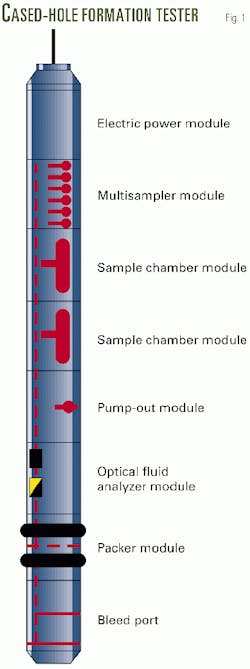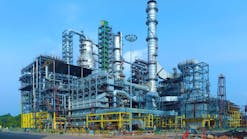Experience in 1999 during appraisal of the Peng Lai 19-3 field, off China, showed that a cased-hole formation tester has numerous benefits with few drawbacks.
This concluding article of a two-part series describes the cased-hole formation tester tool as well as a testing procedure developed during the work at Peng Lai 19-3. This Bohai Bay field has numerous layered, productive zones with a wide range of reservoir pressures, fluid properties, and formation permeabilities.
As discussed in the first article (OGJ, June 11, 2001, p. 49), the cased-hole tester appraised many reservoirs in the field that would have been difficult or expensive to test with drillstem (DST) tools or a wireline openhole formation tester. The accompanying box lists some of the benefits and limitations of the tool.
Tool description
Schlumberger's Modular Formation Dynamics Tester (MDT) tool was the cased-hole formation tester used at Peng Lai 19-3. Its modular design consisted of several components (Fig. 1), as follows:
- Gamma ray and collar locator.
- Multisampler module with six monophasic chambers.
- Large-volume sample chambers.
- Pump-out module.
- Fluid-analyzer module.
- Packer module.
- Bleed port.
For water zones, an additional probe module allowed the use of a resistivity cell.
The multisample module collected monophasic samples suitable for full pressure-volume-temperature (PVT) analysis. Surface commands directed the fluid into one of the specified 250-cc sample chamber bottles. This made it possible to take multiple samples at one tool setting depth, or single samples at different depths.
The tool also had large-volume sample chambers, (1, 2.75, and 6 gal) that were run in different combinations. At Peng Lai 19-3, length and weight limitations prevented running on wireline more than four of these large chambers per descent. Surface-controlled commands directed fluid to the selected chamber via electromechanically actuated seal valves.
The pump-out module pumped the sampled fluid from the formation into the borehole while operators monitored fluid type at surface. When the operators determined that the fluid quality was representative of reservoir fluids, they sent commands that directed the pump output to a sample chamber, capturing a formation fluid.
The pump-out module also served for inflating and deflating the straddle packer and for pumping between the packers.
After the module pumps mud from between the packer elements, the first fluid to flow is the mud filtrate from the near-wellbore environment. Early samples contain mixtures of mud filtrate and virgin formation fluids, with the mix depending on numerous factors such as pump time and filtrate invasion depth.
As pumping continues, the ratio of mud filtrate to formation fluid drops to an acceptable contamination level.
Concerns regarding contamination levels depend in large part on whether the fluids are immiscible or miscible.1 Contamination is more critical when fluids are miscible, and less so when they are immiscible because immiscible fluids generally can be separated. The latter was true for Peng Lai 19-3, where a water-based mud system was used.
The fluid analyzer module provides the data for identifying gas, oil, and water, and for estimating the percentage of each. It identifies liquid components in the tool's flow stream with a combination of visible and near-infrared optical absorption spectrometry. The module records the intensity of light transmitted through the tool flowline fluid at various wavelengths.
From the flowline fluid measurements, one can calculate sample contamination for a wide range of complex environments. This was an invaluable feature in light of the complex and variable reservoirs at Peng Lai 19-3.
Polarized light reflection measurements detect gas by using the difference in liquid and gas refractive indices. Gas present in the tool flowline, therefore, can be monitored in real time. This ensures that pressures remain above bubblepoint, preventing the gas from evolving from the solution during sampling.
The collection of a representative reservoir fluid sample requires one to determine and maintain proper sampling conditions, pressures in particular that prevent solution gas from evolving.
At Peng-Lai 19-3, the dual-packer module employed two inflatable packers to isolate the borehole interval for testing. Although the spacing between the packers varied, the distance was typically about 3 ft. The dual-packer configuration provided greater flow area than was possible with the openhole formation tester probe. Therefore, fluids could be withdrawn at higher flow rates, again without pressure dropping below the bubblepoint.
Extension mandrels, when appropriate, increased the spacing by 2 ft, which allowed a 3-ft perforation interval, rather than the usual 1-ft interval. This set-up increased the pump time because of the increased volume between the packer elements.
In the Peng Lai 19-3 formations, the increased perforation interval did not significantly reduce the drawdown and was, therefore, not worth the added pump times. A bleed port at the bottom of the tool string equalized pressures across the pump-out module, thus preventing damage to the module when reversing pumping direction.
Test procedure
A typical cased-hole tester operation involves perforating a 1-ft interval via wireline, setting the testing tool across the perforations with straddle packers, and pumping formation fluids through the tool to catch representative samples.
As the testing team members gained experience, they fine-tuned this procedure continuously to acquire better data and expand the scope of the tool. During this process, the team developed a standardized procedure for obtaining high-quality fluid samples and pressure data suitable for transient analysis.
In this process, the team selected a 1-3 ft interval within a larger zone for perforating, usually one with the highest permeability. The high-permeability criterion, however, was balanced with the need to minimize formation cleanup, which could be achieved by placing perforations in a thinner zone or near a bed boundary.
Good cement bond was critical for zonal isolation to prevent crossflow between the larger zone and adjacent sands.
The low formation pressures at Peng Lai 19-3 did not require heavy mud. Most tests were run in a mud containing a viscosified potassium chloride with some barite added for weight. Experience had shown that high mud weights could damage or plug the perforations; therefore, mud weight was maintained at the minimum required for testing.
Properly conditioning the mud and casing was critical for a successful job. This included circulating out all lost circulation materials (LCM) that could plug flowlines, pressure gauges, and valves. Additionally, a casing scraper run made certain that the casing was free of cement. This run also eliminated additional LCM debris and ensured a clean surface to seat the packer.
Typically, single or multiple 41/2-in. casing gun runs perforated the test intervals at 12 shots/ft. After perforating, a wireline lowered the cased-hole formation tester tool to the perforated interval depth. A gamma ray and collar locator aided depth correlation.
Multiple intervals could be tested in a single run. The only limit was the number of samplers and operational limits on the tester tool components, such as the pump-out module and seals.
All perforating and formation testing operations included a wireline blowout preventer (BOP) for well control.
Formation tester operations require the pumping of hydrocarbons into the wellbore above the packers. Therefore, large amounts of gas or light oil could reduce the hydrostatic pressure and possibly cause well control problems. While high-gravity, low-GOR oil found at Peng Lai 19-3 presented minimal risk of this happening, these preventive measures were considered to be good practice.
Once at depth, the operators allowed the pressure gauges to stabilize so that a good hydrostatic pressure could be acquired before setting the packer. This accomplished two things. First, it verified correct readings for both the quartz and strain pressure gauges. Secondly, it established a reference pressure once the packer was deflated.
After seating the packers against the casing, the operators directed the tools to pump fluids from the formation at the lowest pump speed until communication was confirmed. When the flowing pressure dropped below estimated formation pressure, the operators stopped the pump and closed the interval seal valve until pressures stabilized. This initial build-up provided formation pressure and confirmed a good packer-to-casing seal.
The pressure derivative on a log-log plot identified packer leaks and confirmed communication with the formation. A very slow leak could not be detected by monitoring only the pressures. Moreover, larger leaks often would be difficult to detect until pressures continued to climb at the end of the build-up.
If the log-log derivative indicated a leak, the operators inflated the packers to a higher pressure and the build-up test was rerun. Occasionally, it was necessary to deflate the packers and reset them at a higher pressure to obtain a positive seal.
Sampling the flow commenced after obtaining an initial pressure and verifying a good packer-to-casing seal. The procedure required the formation fluid to be pumped out at the lowest pump speed until a stable flowing pressure was establishing.
If the pressure drawdown was small, operators gradually increased the pump speed in increments of 100 rpm. High-pressure drawdowns could cause significant formation damage and potentially ruin the test.
Pumping continued until fluid samples were as clean as possible, at which point the tool collected a combination of monophasic and large-volume fluid samples. As previously stated, contamination in the water-based mud was a minor issue because water and hydrocarbon could be separated in the laboratory. The primary concern was to collect sufficient hydrocarbon volume in the sampler for a PVT analysis.
The fluid analyzer determined oil and water fractions, and its accuracy in predicting oil vs. water percentages was later confirmed. Oil breakthrough typically occurred in about 2-3 hr at 300-rpm pump speed after pumping 30 l., which corresponded to the volume between the packers. Clean-up then continued for another 6-10 hr or until oil fractions were high enough to fill the samplers. A 75-80% oil fraction would yield enough oil volume in the monophasic samplers for PVT analyses.
Pump times depended on permeabilities and fluid properties, as well as zone thickness and cement isolation. High-viscosity oil or low-permeability zones could require up to four times more pump volumes. After collecting all the samples, the operators continued pumping to ensure a stable flow period before the pressure build-up test, which required stopping the pump and closing the interval seal valve.
A minimum shut-in period of 2 hr provided the best results in these particular formations.
Closing the seal valve minimized leakage past the pump, which by itself did not always provide a positive pressure seal. To prevent early time data from being distorted, the operators stopped the pump first and then closed the seal valve almost simultaneously. Changing the sequence or delaying valve closure resulted in poor data and interpretation difficulties.
As the team gained experience, it found that taking the build-up before sampling was preferable. This reduced total test time and eliminated the flow rate changes that would occur from sampling operations before the pressure transient test. The sampling operations, however, should be conducted first if fluid samples are the primary objective and if little experience has been acquired in a particular area.
Average formation tester pump time lasted about 12 hr for each test. The procedure required an additional 6 hr to correlate depth, set and deflate the packers, acquire initial pressure, and conduct the final build-up test. Perforating took 2-3 hr per interval, and tool rig up and rig-down time was about 2-4 hr.
The test time for a single interval, therefore, ranged from 18 to 24 hr for these relatively shallow formations with moderate mobilities and heavy oil. One could eliminate some rig up and rig-down time when several intervals were tested in one run. Experience showed that the upper limit of the tool's capabilities was a three-interval test in a single run, before pulling and servicing the tools was required.
Future
Plans for the formation tester tool include enhanced capabilities that will enable fluid properties to be identified, such as GOR from downhole measurements on oil that is above the bubblepoint. If there is sufficient need, the MDT tool will be modified to support vertical interference tests using two packer modules.
Also, expanding its pressure transient testing capabilities will broaden the tool's applications to include tests such as flow-after-flow tests for multiflow effects and extended build-up tests for increased radius-of-investigation.
The formation tester tool's overall successful application at Peng Lai 19-3, and its outlook for further enhanced capabilities, provides encouraging news to those searching for a viable alternative to conventional testing methods for streamlined acquisition of quality reservoir data.
Acknowledgments
The authors thank Phillips Petroleum Co. and Schlumberger for permission to publish this series of articles. They also thank Tom Allan and Dwight Peters, both of Schlumberger, for their contributions to this article. In addition, the authors extend their thanks and appreciation to the Chinese National Offshore Oil Co. for its assistance.
Reference
- http://www.reserveusa.com/nrrs/ar/hor1/hor19.htmlCrombie, A., Halford, F., Hashem, M., McNeil, R., Thomas, E.C., Melbourne, G., and Mullins, O.C., "Innovations in Wireline Fluid Sampling," Oilfield Review, Vol. 10, No. 3, Autumn 1998, pp. 26-41.


